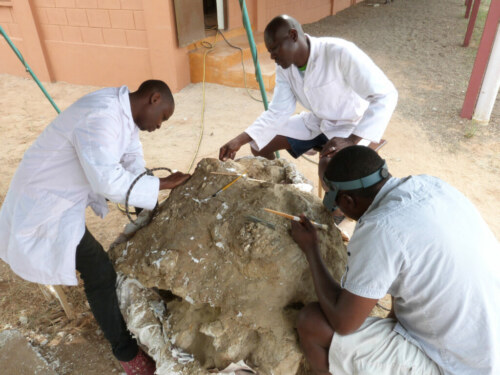
Preparators from the National Museums of Kenya at the Ileret research facility of the Turkana Basin Institute, starting manual preparation and supplementing the field consolidation (chemical hardening) of Loxodonta adaurora cranium KNM-ER 63642. From left to right: Cliff Onyango, Robert Moru and Christopher Kiarie. Image credit: Steve Jabo, Smithsonian Institution
A remarkably well-preserved fossil elephant cranium from Kenya is helping scientists understand how its species became the dominant elephant in eastern Africa several million years ago, a time when a cooler, drier climate allowed grasslands to spread and when habitually bipedal human ancestors first appeared on the landscape.
Dated to 4.5 million years ago and recovered from a site on the northeast side of Lake Turkana, it is the only well-preserved elephant cranium—the portion of the skull that encloses the brain—from that time. It is about 85% intact and holds a wealth of previously unavailable anatomical detail, according to University of Michigan paleontologist William Sanders.
Known by its museum number, KNM-ER 63642, the roughly 2-ton cranium belonged to a massive adult male of the species Loxodonta adaurora, an extinct evolutionary cousin of modern African elephants but not a direct ancestor.
“This elephant skull is by far the most impressive specimen that we have in the Kenyan paleontological collection from Lake Turkana” – Louise Leakey, Koobi Fora Project
Read more on this discovery here





